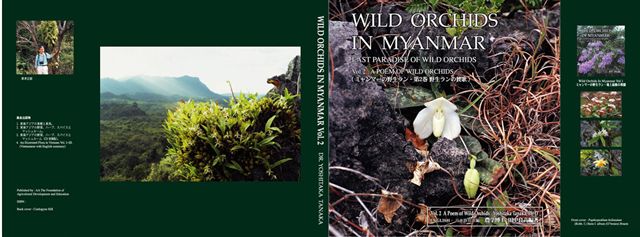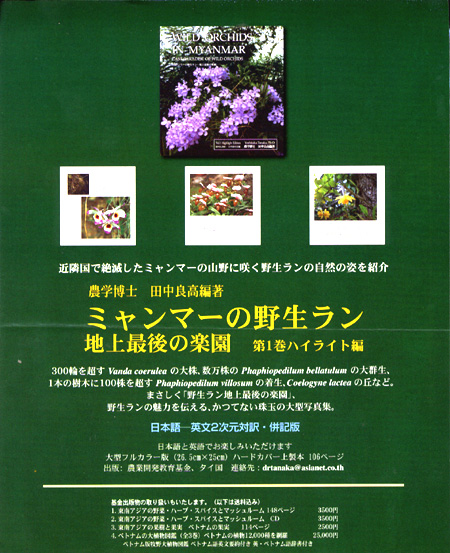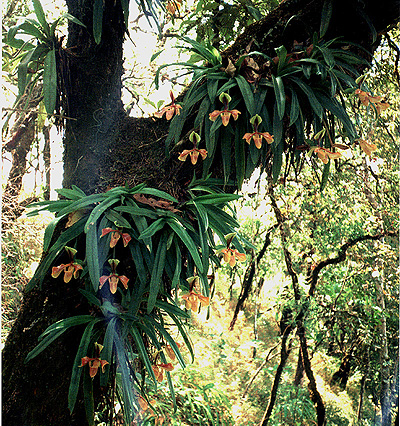|
|
|
In this page, I'll introduce the good news including how to grow Paph. some products for growing etc. in the various kinds of fields in Paph.. CM about fertilizer and some activators will be all right. If you have some good information, please let me know. Thank you. E-mail to Dr. Tanaka : tanatosh@jichi.ac.jp |
|
|
Japanese - English |
| Volume 2. 'A Poem of Wild Orchids ' will be released sooner |
|
Dear Readers of Orchid lover, The contents of New Arrival are as follows; Price: US$40 (exclusively postage) The profit of our publication of the Foundation will be
used to support to establish schools and hospitals for ethnic
minorities and conservation of the plant genetic resources in
Myanmar. Dr. Yoshitaka Tanaka PhD in Bangkok |

|
|
オリジナル大型写真パネル特別配布 購入希望は、本と同様、JPAで受け付けます。 |
|
| Photo Album with hard cover、All color phots , 26.5cmx25cm 106 pages. The 1st one is Vol. 1 , High Light of the world. About 50 species of orchids are introduced with about150 photos. From these photos, we feel the author's enthusiasm for orchids. |
|
Author Dr. Yoshitaka Tanaka PhD He lives in Bangkok , Thailand but fall Myanmar in Love. He visited every month to Myanmar to improve the life style of small number of local nations. |
 |
| The contents (Especially foe Paphs, they are introduce in detail in The Special Program. ) |
|
From his wards、 The purpose of this publishing books is dependent on the responsibility as human beings to keep nature, especially wild orchids and to make the basic education for developing life style of the local nations satisfactory. I believe this is my life work. I wish the benefit of taking Photos and of publishing bring back to them. In this meaning, I 'm trying to transfer new species of vegetables that grow well in poor fertilizer from Vet Nab to protect wild orchids that are disappearing by their burning fields. Our job is supporting by the military governments and local agricultural administration as one of agricultural developing projects. This boos will be series of 7 volumes. The first one is the highlight. The second one will be published in May. This one will be much more exciting one. As I explained in Japanese and English, I believe so many orchid lovers around the world to enjoy. I 'm confident of the merits of this series. |
| In this book, we will be surprised with many remarkable photos of orchids in nature that we have never seen before. I would strayed in to the past time when orchids was not disturbed yet. I wish these nature will be kept in future as they are. I pray from the bottom of my heart. And some day, I want to visit this dreamy wild world..... Don't you think so, too ? |
| From the book, only a few photos of Paphs will be introduced now. |
 |
| As I don't have a scanner for A4 size, the under part of this book was disappeared. The book is 26.5cmx25cm with a hard cover. |
|
|
|
Paphiopedilum in Myanmar (From the book) Phaphiopediium species Most of the Paphiopedilum species are threatened towards extinction in the wild due to over collection. Their exotic shape, color and rarity attract the heart and minds of many collectors. Myanmar in the north is connected to the Himalayan mountain range through 6,000 m high summit, and has borders with India, Bangladesh, China, Laos and Thailand and connected to the Anderman Sea in the south Malaysian border. This provides a climatic environment most suitable for growing Paphiopedilum species and for conserving abundant genetic resources. So far nine species of Paphiopedilum were identified in Myanmar but more can be expected if mountainous terrain and forrnidable borders areas can be explored. Meanwhile, as immediate measure for protecting the rare species, national parks and sanctuaries need to be established as a treasure chest for humans. During a series of surveys, more than ten thousand plants of Paphiopedilum bellatulum were found in a carpet form under a Iow shrubbery close to a housing development. Development is inevitable and will never stop. Our duty is to keep a visual record for future generation and maintain some specimens in the Kandawgyi and Inlay Botanical Gardens. ( By Dr. Y. Tanaka ) |
 |
|
|